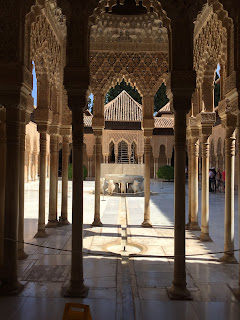We walked through it twice; once by day, once by night. On our night in the Alhambra,

the moon was shining. The ornate interior facades were mirrored in the still water of the reflecting pools. The air was cool. We shared the space with very few people. The sultan's palace has buildings for various purposes. One for receiving solicitors. One for entertaining. And one, the most intimate and lovely, the courtyard of the lions, for his residence and being with the harem. The courtyard is lined with elegant slender columns, far more than necessary, over one hundred. They constantly divide your vista. In the center is a fountain supported on the backs of twelve lions. Twelve lions: one for each month, each hour of the day, each sign of the zodiac, etc. The lip of the fountain is engraved with a poem. The poem extols allah, over and over. A significant portion of Alhambra's the engraved plaster wall decoration consists of the written word, allah.
Our hotel, the Parador San Francisco, is part of the Alhambra. When Queen Ysabel and
King Fernando won possesion of the Alhambra from the last sultan, they kept most of the buildings intact, but a few they razed or repurposed. Our hotel was that way. A few bits of the hotel had the islamic moorish decoration, but the remainder of the building was a monastery built by the Spanish in the early 1500's. In it's beautiful courtyard, there is a photo of the building from 100 years ago. It was falling apart, in extreme disrepair. The intervention was made just in time to save all the buildings of the Alhambra.
There is an oil portrait of Queen Ysabel in the lobby. It is not attractive, not something

you'd expect a monarch would approve of. When she died in 1504, she was interred in the islamic part of our building. She and later her husband remained there until their grandson completed, down the hill, the Capilla Real, where their tombs are today. Referring back to the Prado and the Rogier van der Weyden painting, a copy of it hangs facing the marble royal tombs in Granada. There is a funny aside regarding these tombs. Laying beside the king and queen are their daughter and her husband. Folklore says, the daughter's husband, Felipe "el Hermoso", died and a priest convinced her he could revive him so she traveled with her husband's corpse for several years, occasionally lifting the lid to have a peek, until she was declared "loca" Juana "la Loca".
Before visiting the Alhambra, I read Tales of the Alhambra, by Washington Irving. It was like a book of fairy tales and Arabian Nights stories. He lived in one of the palaces in the 1828, when the buildings were in extreme disrepair, when they served neither royal nor political functions. He wrote of looking down to the river, where at night there was always life going on and the sound of the guitar.
There is still the sound of the guitar in Granada. We went to a flamenco establishment,
Peña la Plateria. It functions as a private club and a flamenco school. On site there is a terrace restaurant. We ate Spanish home cooking of simple foods: beans with ham, gaspacho, eggplant with honey. Afterward, we paid our ten euros, sat indoors at our table and enjoyed a young man and his guitar. He mesmerized us for a dozen minutes when a dancer came out to accompany him.
In the twentieth Century, the leading Spanish guitarist, famous enough to be called by one name, Segovia, began his guitar instruction in Granada in 1900. There is a recording of him sharing, in English, his recollections of the streetcars, the bougainvillea, the lovely girls, the magical Alhambra in the moonlight and the sweet perfume of the orangeblossoms. We have been there and every thing he said is still true.
Wes and Marlow
Granada, September 20-24, 2017
you'd expect a monarch would approve of. When she died in 1504, she was interred in the islamic part of our building. She and later her husband remained there until their grandson completed, down the hill, the Capilla Real, where their tombs are today. Referring back to the Prado and the Rogier van der Weyden painting, a copy of it hangs facing the marble royal tombs in Granada. There is a funny aside regarding these tombs. Laying beside the king and queen are their daughter and her husband. Folklore says, the daughter's husband, Felipe "el Hermoso", died and a priest convinced her he could revive him so she traveled with her husband's corpse for several years, occasionally lifting the lid to have a peek, until she was declared "loca" Juana "la Loca".














Wonderfully descriptive text and great pics, as always!
ReplyDelete